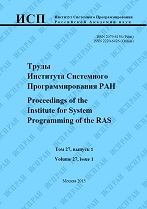|
On the possibility of secure program obfuscation in some model of cloud computing
A. V. Sokurovab, I. V. Abramovac, N. P. Varnovskiibca, V. A. Zakharovcabd
a Moscow Institute of Physics and Technology (State University)
b Ivannikov Institute for System Programming of the Russian Academy of Sciences
c Lomonosov Moscow State University
d National Research University Higher School of Economics
Abstract:
In this paper we study the possibility of using a certain cloud computing model supplied with cryptoservers to obfuscate software programs. Earlier, we proposed this cloud computing model in our study of some information security problems for multi-client distributed computing over encrypted data. Based on this model, we proposed a new approach involving the use of threshold homomorphic cryptosystems for program obfuscation. The main result of this paper is a new definition of the resistance of obfuscation of programs in the cloud computing model and a theorem proving the cryptographic strength of the proposed algorithm of obfuscation of programs under the assumption of the existence of cryptographically strong threshold homomorphic encryption systems. The paper is organized as follows. In the introducing section we discuss the main aspects of the information security problems for cloud computing systems. Section 2 provides a description of the obfuscation program objectives, as well as a brief overview of the main achievements in its study. The next section provides general information about homomorphic cryptosystems. Section 4 describes a more special class of homomorphic cryptosystems - threshold homomorphic encryption systems. Section 5 introduces the cloud computing model, which is used as framework for our program obfuscation techniques. For this computing environment, in Section 6, the definition of the cryptographic strength of program obfuscation is formulated, a new method of program obfuscation using threshold homomorphic cryptosystems is described, and the cryptographic strength of the proposed obfuscation algorithm is proved.
Keywords:
program obfuscation, homomorphic encryption, security, cloud computing.
Citation:
A. V. Sokurov, I. V. Abramova, N. P. Varnovskii, V. A. Zakharov, “On the possibility of secure program obfuscation in some model of cloud computing”, Proceedings of ISP RAS, 31:6 (2019), 145–162
Linking options:
https://www.mathnet.ru/eng/tisp474 https://www.mathnet.ru/eng/tisp/v31/i6/p145
|

| Statistics & downloads: |
| Abstract page: | 267 | | Full-text PDF : | 112 | | References: | 23 |
|




 Contact us:
Contact us: Terms of Use
Terms of Use
 Registration to the website
Registration to the website Logotypes
Logotypes









 Citation in format
Citation in format 